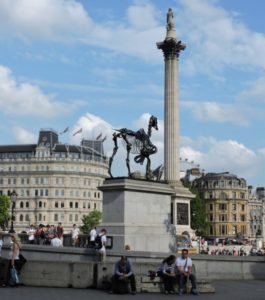
Trafalgar Square’s Fourth Plinth, at the time occupied by Hans Haacke’s sculpture Gift Horse (photo courtesy of Thomas Nugent)
London’s Trafalgar Square has a plinth at each of its four corners. Three of them have statues, while one has nothing on top of it. It was originally meant to have an equestrian statue of King William IV, but not enough money was raised for the project. For one hundred fifty years, the pedestal remained empty. It wasn’t until 1999 that British arts organizations began to use the empty plinth to exhibit contemporary works of art. Since 2005, the Fourth Plinth Commission has chosen the new works, rotating out every two years. And just this past weekend, the organization announced their two latest pieces meant to mount the plinth in 2026 and 2028.
Since September 2022, the fourth pedestal in Trafalgar Square has been the home of Samson Kambalu’s sculpture Antelope. The work recreates a 1914 photograph of Baptist minister and anti-colonialist activist John Chilembwe with British missionary John Chorley. In September, Antelope will be replaced with Teresa Margolles’s sculpture 850 Improntas, which will take its place in Trafalgar Square from 2024 to 2026. 850 Improntas consists of a series of plaster casts the artist took from the faces of several hundred transgender people. Drawing on her Mexican heritage, Margolles designed 850 Improntas in the style of a tzompantli, a rack indigenous people in Mexico and Central America used to display human skulls. These were often the skulls of human sacrifices, and many archaeological sites in the region show relief sculptures on buildings meant to represent these tzompantli. Before becoming an artist, Margolles was a forensic pathologist and a mortician in Mexico City. She drew from her experiences witnessing the effects of anti-trans violence in her own country to create this poignant memorial for those suffering today.
But now, the Fourth Plinth Commission has chosen what will come after 850 Improntas. In 2026, the fourth plinth will become the home of Lady in Blue by Tschabalala Self. It is a bronze sculpture of a woman in a lapis lazuli dress, representing modern, urban womanhood. Self sought to create something that represented all women, contrasting with the statues of famous men that occupy the other pedestals around Trafalgar Square. According to the artist, “She is not an idol to venerate or a historic figurehead to commemorate. She is a woman striding forward into our collective future with ambition and purpose. She is a Londoner, who represents the city’s spirit.”
The work set to replace Lady in Blue in 2028 is an untitled resin sculpture by Andra Ursuța meant to represent a horse and a rider under a shroud. Horse-themed works have been chosen in the past, which is appropriate given the equestrian statue on the other side of the square. A statement from the Mayor of London’s office asks, “Is it yet to be uncovered? Or is it an already canceled public monument – a ghost of history, a parody of itself?”
Being chosen to appear in Trafalgar Square has become one of the most prestigious opportunities granted to contemporary artists over the last few decades. Previous exhibitors include the sculptor Antony Gormley, whose performance art piece One & Other consisted of one person mounting the pedestal every hour for a hundred days straight. These people were free to do whatever they wanted, from performing science experiments to reading poetry to dressing up like Godzilla and destroying a cardboard replica of London. Some have proposed ideas for permanent statues to occupy the plinth, with subjects ranging from Queen Elizabeth II to Margaret Thatcher to Alan Turing. However, like many, I think accessibility is an important aspect of art. Art events like exhibitions, gallery openings, and biennial shows in Venice can often seem like closed-off spaces. Therefore, bringing art into people’s lives can improve both their lives and the state of art in society. Like Keith Haring’s drawings in the New York subway or any concrete wall in Banksy’s path, Trafalgar Square’s fourth plinth serves that purpose.
